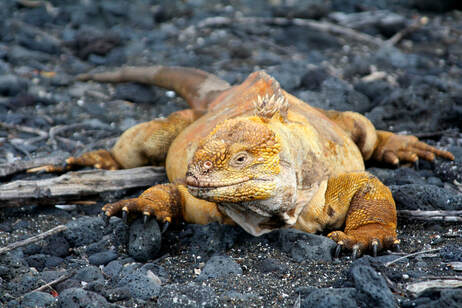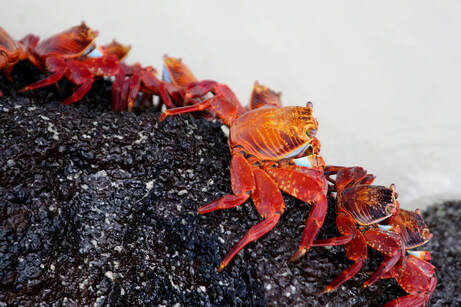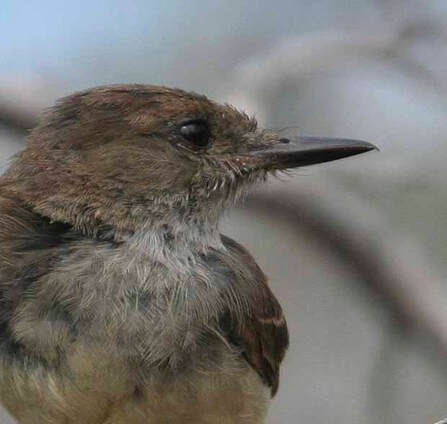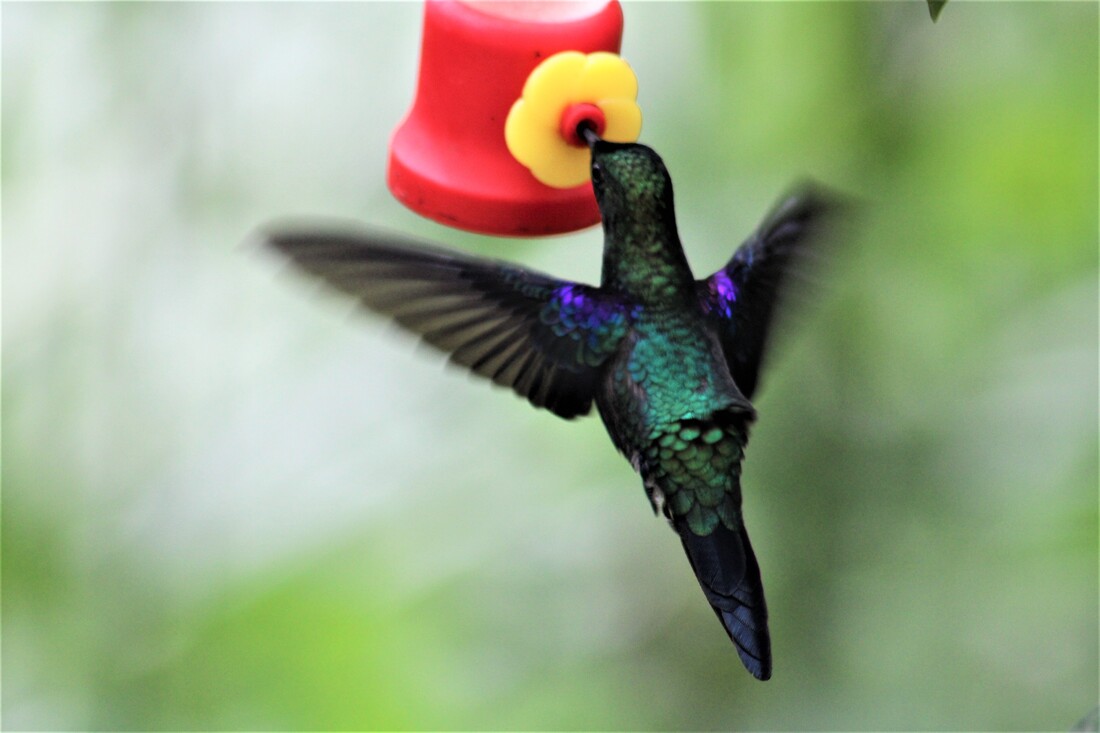April 19, 2021 – April 28, 2021
|
|
Join us on our next adventure! David and Blair hosted a trip to Ecuador and the Galapagos on April 19, 2021. And though the trip is over and you can see some of what we did on this video as well as our itinerary below you can see our itinerary. We have more trips planned that you can see here . |
3 minute 45 second video
The Galapagos Islands are an extraordinary destination made famous by Darwin. How can I be so sure? I have been there twice and look forward to a third time. Being personally experienced with different types of touring, I have created a tour that I believe captures the best of Ecuador and the Galapagos, at a lower price than many tours, and with a more enriching and interesting itinerary.
The Galapagos is located about 600 miles off of the west coast of Ecuador and emerged through volcanic eruptions which sometimes gives them an otherworldly look. The archipelago consists of 19 islands that dot an area that covers approximately 25,000 square miles. The term “Enchanted Islands” was used by early navigators referring to the fact that these islands seemed to “appear and disappear” because the islands are sometimes hidden by fog and literally disappear from sight.
Three factors have caused the Galapagos to be a veritable museum of evolution: being far from the mainland, differences in topography on each island, and the distance between the islands is great so that the wildlife on each island is isolated. The differences are so distinct that, as an example, it is possible to tell which island a tortoise, finch or iguana comes from by its markings and features. In addition, a lack of natural predators means the wildlife in the Galapagos has no fear of humans so it is easy to observe close-up and it is possible to easily get National Geographic style pictures.
We will begin our trip by flying into Quito, the capital of Ecuador, in the Andean foothills at an elevation of 9,350 feet. Quito is known for its largely intact Spanish colonial center where we will meet local people and experience the culture on a private tour called “Quito Like a Local” described in detail below.
With Quito is our base, we are close enough to drive to the Mindo Cloud Forest - one of Ecuador’s best kept secrets. In this private tour, we will experience the landscape and climate in Mindo which is ideal for the more than 450 different types of birds, numerous species of exotic butterflies, and a variety of animals and reptiles who call the cloud forest home.
The Galapagos is located about 600 miles off of the west coast of Ecuador and emerged through volcanic eruptions which sometimes gives them an otherworldly look. The archipelago consists of 19 islands that dot an area that covers approximately 25,000 square miles. The term “Enchanted Islands” was used by early navigators referring to the fact that these islands seemed to “appear and disappear” because the islands are sometimes hidden by fog and literally disappear from sight.
Three factors have caused the Galapagos to be a veritable museum of evolution: being far from the mainland, differences in topography on each island, and the distance between the islands is great so that the wildlife on each island is isolated. The differences are so distinct that, as an example, it is possible to tell which island a tortoise, finch or iguana comes from by its markings and features. In addition, a lack of natural predators means the wildlife in the Galapagos has no fear of humans so it is easy to observe close-up and it is possible to easily get National Geographic style pictures.
We will begin our trip by flying into Quito, the capital of Ecuador, in the Andean foothills at an elevation of 9,350 feet. Quito is known for its largely intact Spanish colonial center where we will meet local people and experience the culture on a private tour called “Quito Like a Local” described in detail below.
With Quito is our base, we are close enough to drive to the Mindo Cloud Forest - one of Ecuador’s best kept secrets. In this private tour, we will experience the landscape and climate in Mindo which is ideal for the more than 450 different types of birds, numerous species of exotic butterflies, and a variety of animals and reptiles who call the cloud forest home.
|
Quito Like a Local tour - 1 minute Video
Mindo Cloud Forest & Archaeological Museum 39 second video
|
Day 1 – QUITO, ECUADOR – Monday 4/19/21
Arrive in Quito from the US and take a private transfer between the Mariscal Sucre Airport of Quito and the hotel in Quito. Overnight: Casa Gangotena Boutique Hotel Day 2 QUITO LIKE A LOCAL Tuesday 04/20/21 (B/L/-) We head out for a walking tour of the Old Town, intent on understanding more about the people who live in the largest and best-restored historical center in the Americas. We begin by meeting our local resident guide, part of a grassroots NGO organization that has created a walking tour of its Quito neighborhood, called San Roque. The guide takes us through the nearby streets, stopping to meet artisans, shopkeepers, hat makers and sweet confectioners. Up the hill on Calle Rocafuerte, we explore the San Francisco Market, one of the oldest in the capital. Here, we learn all about the fruits and vegetables produced in Ecuador and some culinary traditions. We also have the chance to meet and learn from one of the local herbal healers who have locales in the market. From the market, we walk downhill to the emblematic street of La Ronda, considered one of the flagship regeneration projects in the city. It’s a quiet, cobbled street with typical balconies overflowing with geraniums. Here we visit the Manos en La Ronda project and meet artisans in the workshops. We then visit the chocolatier on the ground floor, where we enjoy a snack and have a chance to discover and taste the finest chocolate in the world – which, of course, comes from Ecuador! From La Ronda, we walk northwards through the handsome streets of the Old Town to the Plaza Grande, the political heart of the city. Following a brief explanation, we stroll to the Jesuit church of La Compañía with its stunning gold-leaf interior. Returning back to Plaza San Francisco, we visit the church, choir and pretty patios of the Franciscan order before arriving at Casa Gangotena, on the same square, for a lunch of Ecuadorian specialties prepared by the hotel’s talented chefs. In the afternoon, we cross the street to the excellent Casa del Alabado Archaeological Museum. It houses a fantastic collection of pieces dating back some 5,000 years, arrayed beautifully within a restored 17th-century colonial mansion. This tour also includes a visit to a panoramic viewpoint to appreciate Quito in all its Andean splendor. Overnight: HOTEL CASA GANGOTENA |
Casa Gangotena Boutique Hotel - 45 second Video
|
|
Day 3 – QUITO / CLOUD FOREST/ QUITO – Wednesday 4/21/21 (B/L/-)
The Valley of Mindo is within the protected Mindo-Nambillo forest, located a short two-hour drive to the northwest of Quito. The 48,000-acre (19,200 hectares) Forest stretches over the slopes of Pichincha Volcano and covers diverse ecosystems ranging from the cloud-high, treeless plateau or " paramo" through subtropical forest to tropical jungle. A first short stop is made at the rim of the crater of the extinct Pululahua Volcano, before descending into the Valley of Mindo. Specially trained guides introduce visitors to the mysteries of the Cloud Forest, pointing out the unique flora and fauna. Visit the El Pahuma Orchid Reserve and its Orchid Botanical Garden with flowering orchids mounted on the trees and placed in the vegetation along the trail, consistent with each species' habitat. Labels identify each specimen. Then, a hike on a trail through lush, epiphyte-laden cloud forest, alongside a lively, sparkling creek to the 50 meter (165 foot) Pacaya waterfall. The El Pahuma Orchid Reserve is a privately owned forest of an Ecuadorian family who is searching for a viable economic alternative to destructive activities such as logging or cattle raising, and it protects over 600 hectares (over 1500 acres) of tropical montane forest. Over 170 species of orchids have been identified within the reserve, which lies in a region with some of the highest rates of plant endemism in the world. Orchids, bromeliads, heliconias, ferns, vines, mosses and lichens grow in abundance here. Continue to the quaint little village of Mindo, at an altitude of 1300 meters, observing the bird life along the way. BirdLife International has designated Mindo as an IBA (Important Bird Area), the first such site in South America. Then, a visit to the Butterfly Vivarium, housing 25 varieties of butterflies. Flight areas simulate the outside forest with water streams, mineral deposits, and a wide range of wild flowers. Hundreds of caterpillars feed on their host plants in their natural environment to assure the best development of pupae and butterflies. Lunch is served at a restaurant of the area. Time for a short stroll in the surroundings before return to Quito. Overnight: Casa Gangotena Boutique Hotel |
 Land Iguana
Land Iguana
Day 4 – QUITO / GALAPAGOS CRUISE– Thursday 4/22/21 through Monday 4/26/21 (B/L/D)
Shuttle service OUT Quito to MV Santa Cruz, between Hotel in Quito and the Mariscal Sucre Airport of Quito.
Ticket Quito-Baltra-Quito (RT) Adult International.
Santa Cruz II – 5 days / 4 nights western itinerary Click this link to a 5 minute video will give you and idea of what the ship and the Galapagos experience is like.
Accommodation: horizon deck cabin
We arrive by plane at Baltra Island and transfer to the dock to board the Santa Cruz II where we receive our welcome introductory briefing, boat drill and lunch.
Dragon Hill (Santa Cruz Island)
A majestic introduction on Dragon Hill sends guests on their way to the western side of the Galapagos archipelago. The north shore of Santa Cruz hosts the fascinating landscapes of Dragon Hill. The first part of our walk passes a brackish-water lagoon frequented by shorebirds, ducks and flamingos, while further inland, the trail offers a beautiful view of the bay and the western islands of the archipelago, as well as the chance to see Galapagos land iguanas.
 Sally light foot crab
Sally light foot crab
Day 5 – GALAPAGOS ISLANDS – 04/23/21 (B/L/D)
Punta Vicente Roca (Isabela Island)
After breakfast, we explore the coast by panga (zodiac), while our naturalist guide explains the dramatic geology of the area, a nesting place for several Galapagos highlights: flightless cormorants, Galapagos penguins, fur seals, boobies, etc. Depending on weather conditions, we can snorkel along the cliffs of this area rich in marine life, seasonally-visited by green sea turtles and oceanic sun fish (Mola mola).
Punta Espinoza (Fernandina Island)
The afternoon is dedicated to exploring the youngest island of the archipelago, Fernandina, which, having no introduced mammals, boasts a very unique environment with a very high density of marine iguanas, who share their space with sea lions, Sally light-foot crabs, hawks, penguins and the flightless cormorants.
Punta Vicente Roca (Isabela Island)
After breakfast, we explore the coast by panga (zodiac), while our naturalist guide explains the dramatic geology of the area, a nesting place for several Galapagos highlights: flightless cormorants, Galapagos penguins, fur seals, boobies, etc. Depending on weather conditions, we can snorkel along the cliffs of this area rich in marine life, seasonally-visited by green sea turtles and oceanic sun fish (Mola mola).
Punta Espinoza (Fernandina Island)
The afternoon is dedicated to exploring the youngest island of the archipelago, Fernandina, which, having no introduced mammals, boasts a very unique environment with a very high density of marine iguanas, who share their space with sea lions, Sally light-foot crabs, hawks, penguins and the flightless cormorants.
Day 6 – GALAPAGOS ISLANDS 04/24/21 (B/L/D)
Puerto Ayora and the Charles Darwin Research Station (Santa Cruz Island)
In the morning, we disembark (dry landing followed by a brief bus ride) for our visit to the Charles Darwin Research Station’s giant tortoise Breeding Centre within an impressive giant prickly-pear cactus forest, home to many land birds. These are the headquarters of scientific investigation, conservation and the National Park administration. Following our visit, we board our transport to enjoy lunch in the cooler highlands of Santa Cruz Island, a completely different ecosystem.
Santa Cruz Island
Puerto Ayora and the Charles Darwin Research Station (Santa Cruz Island)
In the morning, we disembark (dry landing followed by a brief bus ride) for our visit to the Charles Darwin Research Station’s giant tortoise Breeding Centre within an impressive giant prickly-pear cactus forest, home to many land birds. These are the headquarters of scientific investigation, conservation and the National Park administration. Following our visit, we board our transport to enjoy lunch in the cooler highlands of Santa Cruz Island, a completely different ecosystem.
Santa Cruz Island
 Mockingbird
Mockingbird
Day 7 – GALAPAGOS ISLANDS 04/25/21 (B/L/D)
Baroness Tower - Post Office Bay (Floreana Island)
After breakfast, panga ride along the maze of channels on Floreana’s north shore can be enjoyed. We follow this visit by continuing to Baroness Cove with its breathtaking views of Floreana. We land at Post Office Bay to visit the historic barrel that has served as a post office in the archipelago for over two centuries and where postcards are traditionally left for guests from other vessels to hand-deliver to their destinations. This is followed by snorkelling along the beach and then we head back on board for lunch.
Champion Islet– Punta Cormorant (Floreana Island)
Following lunch, we take the pangas and glass-bottom boat to explore the underwater wonders around Champion Islet – an extinct shield volcano, regarded as one of the best snorkelling spots in the archipelago. From there, it’s onwards to Punta Cormorant. We’ll begin with a wet landing on the olivine-crystal beach followed by an easy walk to a brackish-water lagoon, where bird species such as greater flamingos, pintail ducks, common stilts, herons, sandpipers, and others gather. We continue our walk over to a white-sand beach, where sea turtles emerge from the sea at night to nest (from December to May).
Baroness Tower - Post Office Bay (Floreana Island)
After breakfast, panga ride along the maze of channels on Floreana’s north shore can be enjoyed. We follow this visit by continuing to Baroness Cove with its breathtaking views of Floreana. We land at Post Office Bay to visit the historic barrel that has served as a post office in the archipelago for over two centuries and where postcards are traditionally left for guests from other vessels to hand-deliver to their destinations. This is followed by snorkelling along the beach and then we head back on board for lunch.
Champion Islet– Punta Cormorant (Floreana Island)
Following lunch, we take the pangas and glass-bottom boat to explore the underwater wonders around Champion Islet – an extinct shield volcano, regarded as one of the best snorkelling spots in the archipelago. From there, it’s onwards to Punta Cormorant. We’ll begin with a wet landing on the olivine-crystal beach followed by an easy walk to a brackish-water lagoon, where bird species such as greater flamingos, pintail ducks, common stilts, herons, sandpipers, and others gather. We continue our walk over to a white-sand beach, where sea turtles emerge from the sea at night to nest (from December to May).
Day 8 – GALAPAGOS / GUAYAQUIL - Monday April 26, 2021 (B/-/-)
Baltra Island
We disembark at Baltra Island in order to transfer to the airport to take the flight back to the mainland.
Shuttle service IN Guayaquil from MV Santa Cruz, between the Jose Joaquin de Olmedo Airport and the Hilton Guayaquil Hotel.
Overnight: Hilton Colon Guayaquil Hotel.
Accommodation: deluxe room
Day 9/10 – GUAYAQUIL - Tuesday April 27 - 28, 2021 (B/-/-)
April 27 - Optional tours available. On April 28, private transfer between the Hilton Colon Guayaquil Hotel and the Jose Joaquin de Olmedo Airport for our homeward flight. NOTE: An additional hotel night (April 27th) was added to give time to get the results back from the mandatory covid PCR test.
Baltra Island
We disembark at Baltra Island in order to transfer to the airport to take the flight back to the mainland.
Shuttle service IN Guayaquil from MV Santa Cruz, between the Jose Joaquin de Olmedo Airport and the Hilton Guayaquil Hotel.
Overnight: Hilton Colon Guayaquil Hotel.
Accommodation: deluxe room
Day 9/10 – GUAYAQUIL - Tuesday April 27 - 28, 2021 (B/-/-)
April 27 - Optional tours available. On April 28, private transfer between the Hilton Colon Guayaquil Hotel and the Jose Joaquin de Olmedo Airport for our homeward flight. NOTE: An additional hotel night (April 27th) was added to give time to get the results back from the mandatory covid PCR test.





